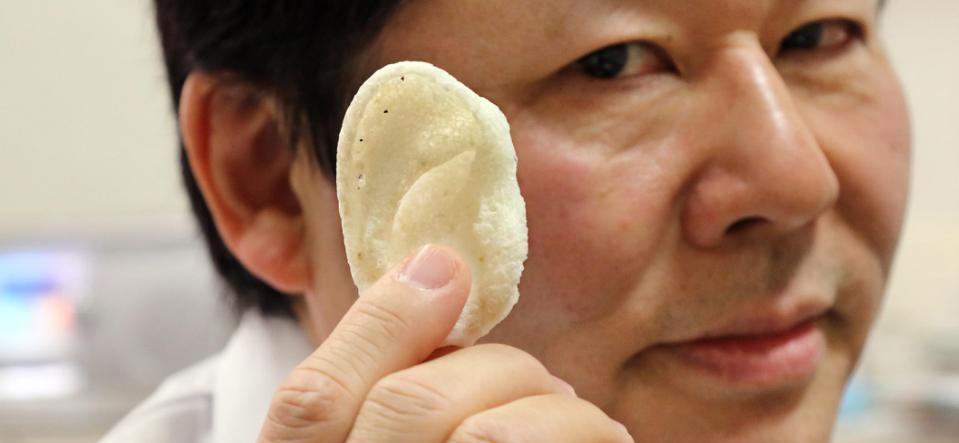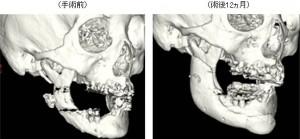Japanese Researchers Say Bone and Tissue Bioprinting Process Could Be A Year Away From Use In Humans
Japanese scientists say they’re well on the way to creating custom-made skin, bone, cartilege and joints using 3D bioprinting technology.
The process combines stem cells – proto-cells capable of developing into nearly any body part – and a synthetic substance similar to human collagen which mimics the structure of organs like the tough outer surface and spongy inside of bones and cartilege.
While groups of researchers around the world have developed small masses of tissue for use as implants, this project aims to take the next step towards making them functional and approved for use in humans. Tsuyoshi Takato, a professor at the University of Tokyo Hospital, says his team has built the next-generation 3D bioprinter which will be used to create custom-fit bone and tissue.
 The process uses data from a Computer Tomography (CT) scans of a patient which allows the implants to fit correctly and quickly become assimilated by real tissue and other organs in the patient.
The process uses data from a Computer Tomography (CT) scans of a patient which allows the implants to fit correctly and quickly become assimilated by real tissue and other organs in the patient.
“We usually take cartilage or bone from the patient’s own body, but these custom-made implants will mean not having to remove source material,” Takato said.
 Takato is the head of the Division of Tissue Engineering at Tokyo University Hospital and says he believes this technology will also offer hope to children born with bone or cartilage deformities. He says the process of using synthetic implants is currently inadequate as the rate of a child’s growth outstrips the usefulness of the implants over time.
Takato is the head of the Division of Tissue Engineering at Tokyo University Hospital and says he believes this technology will also offer hope to children born with bone or cartilage deformities. He says the process of using synthetic implants is currently inadequate as the rate of a child’s growth outstrips the usefulness of the implants over time.
According to Takato, the artificial protein was developed by Fujifilm and came about as the result of that company’s research into collagen for use in photographic films. While it’s modeled on human collagen, it doesn’t derive from animals, but it can be easily assimilated in human bodies and can reduce the risk of infections which can occur in live tissue implant procedures.
Takato says clinical tests of 3D printed skin will be followed by tests of materials and processes to build bones, cartilage and joints, but he adds that the main hurdle holding the project back – the heat generated by conventional 3D printers, which damages living cells and protein, is still being studied.
“We haven’t fully worked out how to avoid heat denaturation, but we already have some models and are exploring which offers the most efficient method,” Takato says.
 The work sprung from a previous project called “CT-Bone” by Tokyo-based firm Next 21 KK. That technique uses calcium phosphate, the substance that makes up real bones, but does not contain stem cells. The CT-Bone implants are inserted into broken bones or areas lacking necessary bony structures and act as a “scaffolding” to promote new bone growth.
The work sprung from a previous project called “CT-Bone” by Tokyo-based firm Next 21 KK. That technique uses calcium phosphate, the substance that makes up real bones, but does not contain stem cells. The CT-Bone implants are inserted into broken bones or areas lacking necessary bony structures and act as a “scaffolding” to promote new bone growth.
Takato says testing in animals has indicated that tissue and bone regeneration will proceed more quickly when implants that use collagens, stem cells and growth stimulus are used. He adds that Japanese medical authorities are expected to grant approval for the process soon, and that the 3D bioprinter will be available commercially during 2015 if Japan’s Pharmaceutical and Medical Devices Agency (PMDA) approves the device and the process.
Japan’s New Energy and Industrial Technology Development Organization (NEDO), RIKEN at Tokyo University and Japanese medical research firm NEXT 21 K.K. were part of the project, and they say the bioprinter can produce artificial bones with details and shaping accuracy down to 0.1mm.
Are you aware of any other 3D bioprinting research which is awaiting approval from medical authorities? Let us know in the Bone and Tissue Bioprinting Process forum thread on 3DPB.com.
Subscribe to Our Email Newsletter
Stay up-to-date on all the latest news from the 3D printing industry and receive information and offers from third party vendors.
You May Also Like
Further Understanding of 3D Printing Design at ADDITIV Design World
ADDITIV is back once again! This time, the virtual platform for additive manufacturing will be holding the first-ever edition of ADDITIV Design World on May 23rd from 9:00 AM –...
3D Printer Maker EVO-tech Reborn as NEVO3D — Once More With Feeling
EVO-tech was a 3D printing service and original equipment manufacturer established in 2013 and based in Schörfling am Attersee, Austria. The company produced high-quality material extrusion systems featuring linear bearings,...
3D Systems Brings 3D Printed PEEK Cranial Implant to the U.S. with FDA Clearance
For more than 10 years, 3D Systems (NYSE:DDD) has worked hand-in-hand with surgeons to plan over 150,000 patient-specific cases, and develop more than two million instruments and implants from its...
CDFAM Returns to Berlin for Second Annual Symposium
The second CDFAM Computational Design Symposium is scheduled for May 7-8, 2024, in Berlin, and will convene leading experts in computational design across all scales. Building upon the first event...































